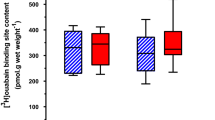Abstract
We have previously reported an acute decrease in muscle buffer capacity (βmin vitro) following high-intensity exercise. The aim of this study was to identify which muscle buffers are affected by acute exercise and the effects of exercise type and a training intervention on these changes. Whole muscle and non-protein βmin vitro were measured in male endurance athletes (VO2max = 59.8 ± 5.8 mL kg−1 min−1), and before and after training in male, team-sport athletes (VO2max = 55.6 ± 5.5 mL kg−1 min−1). Biopsies were obtained at rest and immediately after either time-to-fatigue at 120% VO2max (endurance athletes) or repeated sprints (team-sport athletes). High-intensity exercise was associated with a significant decrease in βmin vitro in endurance-trained males (146 ± 9 to 138 ± 7 mmol H+·kg d.w.−1·pH−1), and in male team-sport athletes both before (139 ± 9 to 131 ± 7 mmol H+·kg d.w.−1·pH−1) and after training (152 ± 11 to 142 ± 9 mmol H+·kg d.w.−1·pH−1). There were no acute changes in non-protein buffering capacity. There was a significant increase in βmin vitro following training, but this did not alter the post-exercise decrease in βmin vitro. In conclusion, high-intensity exercise decreased βmin vitro independent of exercise type or an interval-training intervention; this was largely explained by a decrease in protein buffering. These findings have important implications when examining training-induced changes in βmin vitro. Resting and post-exercise muscle samples cannot be used interchangeably to determine βmin vitro, and researchers must ensure that post-training measurements of βmin vitro are not influenced by an acute decrease caused by the final training bout.



Similar content being viewed by others
References
Bate Smith EC (1938) The buffering of muscle in rigor; protein, phosphate and carnosine. J Physiol 92:336–343
Bell GJ, Wenger A (1988) The effect of one-legged sprint training on intramuscular pH and nonbicarbonate buffering capacity. Eur J Appl Physiol 58:158–164
Bishop D, Edge J, Thomas C, Mercier J (2007) High-intensity exercise acutely decreases the membrane content of MCT1 and MCT4 and buffer capacity in human skeletal muscle. J Appl Physiol 102:616–621
Bishop D, Edge J, Thomas C, Mercier J (2008) Effects of high-intensity training on muscle lactate transporters and postexercise recovery of muscle lactate and hydrogen ions in women. Am J Physiol Regul Integr Comp Physiol 295:R1991–R1998
Blomstrand E, Saltin B (1999) Effect of muscle glycogen on glucose, lactate and amino acid metabolism during exercise and recovery in human subjects. J Physiol 514:293–302
Christensen H (1966) Protein as buffers. Ann N Y Acad Sci 133:34–40
Davey C (1960) The significance of carnosine and anserine in striated skeletal muscles. Arch Biochem Biophysiol 89:296–302
Dohm GL, Puente F, Smith C, Edge A (1978) Changes in tissue protein levels as a result of endurance exercise. Life Sci 23:845–850
Dupin A, Stvolinski S (1986) Changes in carnosine levels in muscles working in different regimens of stimulation. Biokhimiia 51:160–164
Edge J, Bishop D, Goodman C (2006) Effects of chronic NaHCO3 ingestion during interval training on changes to muscle buffer capacity, metabolism, and short-term endurance performance. J Appl Physiol 101:918–925
Edge J, Bishop D, Goodman C (2006) The effects of training intensity on muscle buffer capacity in females. Eur J Appl Physiol 96:97–105
Edge J, Goodman C, Bishop D (2006) Very high-intensity interval training with short rest periods decreases muscle buffer capacity. ECSS Conference, Laussane:477
Esbjornsson-Liljedahl M, Sundberg CJ, Norman B, Jansson E (1999) Metabolic response in type I and type II muscle fibers during a 30-s cycle sprint in men and women. J Appl Physiol 87(4):1326–1332
Eydoux N, Py G, Lambert K, Dubouchaud H, Prefaut C, Mercier J (2000) Training does not protect against exhaustive exercise-induced lactate transport capacity alterations. Am J Physiol Endocrinol Metab 278:E1045–E1052
Favero TG, Zable AC, Bowman MB, Thompson A, Abramson JJ (1995) Metabolic end products inhibit sarcoplasmic reticulum Ca2 + release and [3H]ryanodine binding. J Appl Physiol 78:1665–1672
Furst P, Jonsson A, Josephson B, Vinnars E (1970) Distribution in muscle and liver vein protein of 15N administered as ammonium acetate to man. J Appl Physiol 29:307–312
Gore CJ, Hahn AG, Aughey RJ, Martin DT, Ashenden MJ, Clark SA, Garnham AP, Roberts AD, Slater GJ, McKenna MJ (2001) Live high:train low increases muscle buffer capacity and submaximal cycling efficiency. Acta Physiol Scand 173:275–286
Harmer AR, McKenna MJ, Sutton JR, Snow RJ, Ruell PA, Booth J, Thompson MW, Mackay NA, Stathis CG, Crameri RM, Carey MF, Eager DM (2000) Skeletal muscle metabolic and ionic adaptations during intense exercise following sprint training in humans. J Appl Physiol 89:1793–1803
Harris RC, Marlin DJ, Dunnett M, Snow DH, Hultman E (1990) Muscle buffering capacity and dipeptide content in the thoroughbred horse, greyhound dog and man. Comp Biochem Physiol 97A:249–251
Hultman E, Del Canale S, Sjoholm H (1985) Effect of induced metabolic acidosis on intracellular pH, buffer capacity and contraction force of human skeletal muscle. Clin Sci 69:505–510
Hultman E, Sahlin K (1980) Acid-base balance during exercise. Exerc Sport Sci Rev 8:41–128
Jubrias SA, Crowther GJ, Shankland EG, Gronka RK, Conley KE (2003) Acidosis inhibits oxidative phosphorylation in contracting human skeletal muscle in vivo. J Physiol 533:589–599
Juel C (1997) Lactate-proton cotransport in skeletal muscle. Physiol Rev 77:321–358
Juel C (1998) Muscle pH regulation: role of training. Acta Physiol Scand 162:359–366
Katz A, Broberg S, Sahlin K, Wahren J (1986) Muscle ammonia and amino acid metabolism during dynamic exercise in man. Clin Physiol 6:365–379
Lenz G, Martell A (1968) Metal complexes of carnosine. Biochemistry 3:750–753
Mannion AF, Jakeman PM, Dunnett M, Harris RC, Willan PL (1992) Carnosine and anserine concentrations in the quadriceps femoris muscle of healthy humans. Eur J Appl Physiol Occup Physiol 64:47–50
Mannion AF, Jakeman PM, Willan PLT (1993) Determination of human skeletal muscle buffer value by homogenate technique: methods of measurement. J Appl Physiol 75(3):1412–1418
Marlin DJ, Harris RC (1991) Titrimetric determination of muscle buffering capacity in biopsy samples. Equine Vet J 23:193–197
Parkhouse WS, McKenzie DC (1984) Possible contribution of skeletal muscle buffers to enhanced anaerobic performance; a brief review. Med Sci Sports Exerc 16:328–338
Parkhouse WS, McKenzie DC, Hochachka PW, Ovalle WK (1985) Buffering capacity of deproteinized human vastus lateralis muscle. J Appl Physiol 58(1):14–17
Pedersen TH, Nielsen OB, Lamb GD, Stephenson DG (2004) Intracellular acidosis enhances the excitability of working muscle.[see comment]. Science 305:1144–1147
Penman KA (1969) Ultrastructural changes in human striated muscle using three methods of training. Res Q 10:722–746
Pilegaard H, Asp S (1998) Effect of prior eccentric contractions on lactate/H+ transport in rat skeletal muscle. Am J Physiol Endocrinol Metab 274:E554–E559
Portner H, Boutilier R, Tang Y, Toews D (1990) Determination of intracellular pH and PCO2 after metabolic inhibition by fluoride and nitilotriacetic acid. Respir Physiol 81:255–274
Sahlin K, Henriksson J (1984) Buffer capacity and lactate accumulation in skeletal muscle of trained and untrained men. Acta Physiol Scand 122:331–339
Sahlin K, Soderlund K, Tonkonogi M, Hirakoba K (1997) Phosphocreatine content in single fibers of human muscle after sustained submaximal exercise. Am J Physiol Cell Physiol 273:C172–C178
Spriet LL, Lindinger MI, McKelvie RS, Heigenhauser GJF, Jones NL (1989) Muscle glycogenolysis and H+ concentration during maximal intermittent cycling. J Appl Physiol 66:8–13
Stathis CG, Febbraio MA, Carey MF, Snow RJ (1994) Influence of sprint training on human skeletal muscle purine nucleotide metabolism. J Appl Physiol 76(4):1802–1809
Street D, Nielsen JJ, Bangsbo J, Juel C (2005) Metabolic alkalosis reduces exercise-induced acidosis and potassium accumulation in human skeletal muscle interstitium. J Physiol 566:481–489
Suzuki Y, Ito O, Takahashi H, Takamatsu K (2004) The effect of sprint training on skeletal muscle carnosine in humans. Int J Sport Health Sci 2:105–110
Wayslishen R, Tomlinson G (1975) pH-dependence of 13C chemical shifts and 13C, H coupling constants in imadozole and L-histidine. Biochem J 147:605–607
Author information
Authors and Affiliations
Corresponding author
Rights and permissions
About this article
Cite this article
Bishop, D., Edge, J., Mendez-Villanueva, A. et al. High-intensity exercise decreases muscle buffer capacity via a decrease in protein buffering in human skeletal muscle. Pflugers Arch - Eur J Physiol 458, 929–936 (2009). https://doi.org/10.1007/s00424-009-0673-z
Received:
Revised:
Accepted:
Published:
Issue Date:
DOI: https://doi.org/10.1007/s00424-009-0673-z




